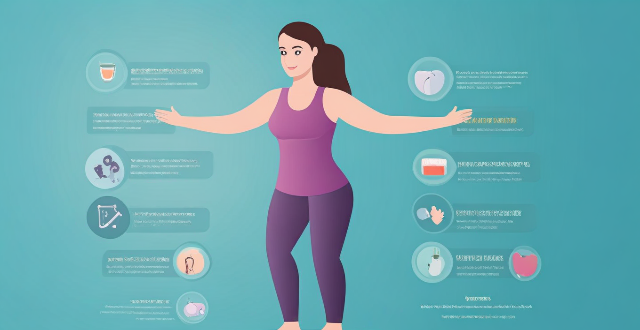Exercise Pain

What should I do if I experience pain during exercise ?
Pain during exercise can be a sign of injury or overexertion. To prevent and manage pain, it is important to warm-up properly, stretch regularly, pay attention to your body's signals, incorporate cross-training, take breaks, drink plenty of water, use proper form, rest and recover, and seek medical advice if necessary. By following these steps, you can reduce the risk of injury and improve your overall fitness.

Is it true that exercise can help manage chronic pain conditions ?
Exercise can help manage chronic pain conditions by reducing pain intensity, improving physical function, enhancing quality of life, and increasing energy levels. It is important to consult with a healthcare professional before starting any exercise program and to start slowly, gradually increasing intensity over time while listening to your body's responses.

How does the idea of 'no pain, no gain' affect people's approach to exercise ?
The "no pain, no gain" philosophy significantly influences people's attitudes toward exercise. While it can boost motivation and discipline, it also poses risks like injuries and overtraining. This mindset may lead to a narrow focus on immediate results, potentially neglecting long-term health goals. It can also negatively affect mental health by causing stress and burnout. Adopting a balanced approach that emphasizes enjoyment, gradual progression, and self-awareness can help achieve fitness goals sustainably without the drawbacks associated with "no pain, no gain."

Can exercise help reduce common pregnancy discomforts like back pain and swelling ?
Exercise can help alleviate common pregnancy discomforts like back pain and swelling by strengthening core muscles, improving posture, enhancing flexibility, promoting circulation, and reducing fluid retention. However, it's important to consult with a healthcare provider before starting any exercise program during pregnancy and follow safety precautions such as starting slowly, avoiding high-impact activities, staying hydrated, and listening to your body.

Can stretching after exercise prevent muscle soreness ?
Stretching after exercise can help reduce muscle soreness and improve flexibility, but it is important to wait for enough time, choose appropriate stretches, be mindful of pain, and use proper technique.

How can I prevent back pain from sitting all day at work ?
Sitting for prolonged periods can lead to back pain, especially if you have a sedentary job. However, there are several ways to prevent back pain from sitting all day at work: 1. Maintain good posture by sitting up straight and adjusting your chair height. Use a footrest if needed and keep your elbows close to your body. 2. Take short breaks every hour to stand up, walk around, and stretch your muscles. Perform desk exercises and stretch regularly to reduce tension. 3. Use ergonomic furniture such as an adjustable chair with lumbar support and an adjustable desk that allows you to alternate between sitting and standing. Place a supportive mat under your chair for additional cushioning and support. 4. Strengthen your core muscles through core exercises, yoga or Pilates, and abdominal exercises like crunches and planks. 5. Practice good habits outside of work by maintaining an active lifestyle, paying attention to your sleeping position, and avoiding heavy lifting.

What is the relationship between endorphins and exercise ?
The text discusses the relationship between endorphins and exercise. It explains that endorphins are hormones released in response to various stimuli, including exercise, which can produce feelings of pleasure, happiness, and relaxation. Physical activity triggers the release of endorphins, reducing pain and discomfort during exercise. The increased blood flow during exercise allows for greater endorphin production, while muscle movement sends signals to the brain to release endorphins, reducing pain perception. The release of endorphins during exercise contributes to an elevated mood, often referred to as a "runner's high." The benefits of endorphin release during exercise include pain reduction, mood enhancement, stress reduction, improved sleep quality, and increased self-esteem. Engaging in regular physical activity can stimulate the release of endorphins, leading to numerous benefits such as pain reduction, mood enhancement, stress relief, improved sleep quality, and increased self-esteem.

How does exercise contribute to bone health ?
Exercise contributes to bone health by increasing bone density, improving balance and coordination, strengthening muscles, improving posture, reducing inflammation, and enhancing cardiovascular health. This reduces the risk of osteoporosis, fractures, back pain, and other health issues.

What role does endorphin release during exercise play in improving mood ?
**The Role of Endorphin Release During Exercise in Improving Mood:** Endorphins, acting as natural painkillers and contributors to feelings of pleasure, play a crucial role in the connection between exercise and mood enhancement. The "Runner's High" phenomenon, characterized by euphoria and reduced pain perception, is attributed to endorphin release during sustained physical activity. Immediate benefits include pain reduction, stress relief, and pleasure induction. Long-term mood enhancement can be achieved through regular exercise habits, chronic pain management, and mental health support. To maximize endorphin release during exercise, individuals should choose enjoyable activities, maintain consistency, gradually increase intensity, stay hydrated and nourished, and incorporate variety. Understanding the role of endorphins can inform lifestyle choices to maximize mood benefits from exercise.

Can exercise help with stress management ?
**Topic:** Can Exercise Help with Stress Management? **Summary:** * **Introduction:** The inevitability of stress and its potential impact on health highlight the importance of effective stress management. Exercise is often touted as a beneficial method for reducing stress. * **Relationship Between Exercise and Stress:** * **Physical Effects:** Exercise triggers endorphins, reduces cortisol levels, and improves sleep quality—all of which contribute to stress reduction. * **Mental Effects:** Enhanced cognitive function, increased self-esteem, and mindfulness techniques associated with exercise can aid in stress management. * **Benefits of Exercise for Stress Management:** * **Physical Benefits:** Improved cardiovascular health, weight management, and pain relief can reduce stress caused by related health issues. * **Mental Benefits:** Exercise can alleviate symptoms of anxiety and depression, improve mood, and increase resilience to stress. * **Practical Tips:** * **Setting Goals:** Start small and choose enjoyable activities to make exercise a sustainable habit. * **Consistency:** Scheduling workouts, finding an accountability partner, and tracking progress can help maintain a regular exercise routine. * **Conclusion:** Exercise is a powerful tool for managing stress, offering both physical and mental benefits. Incorporating it into one's lifestyle can significantly enhance overall well-being and resilience to life's challenges.